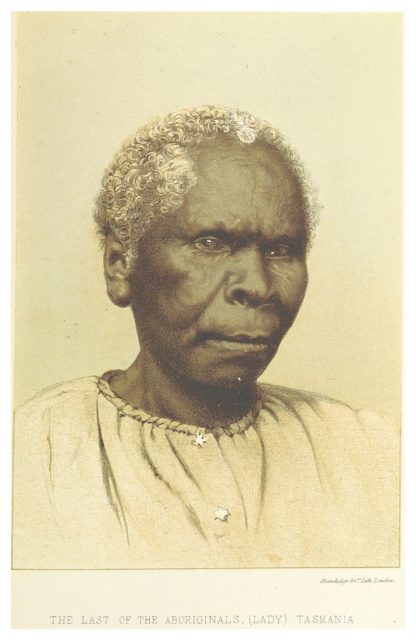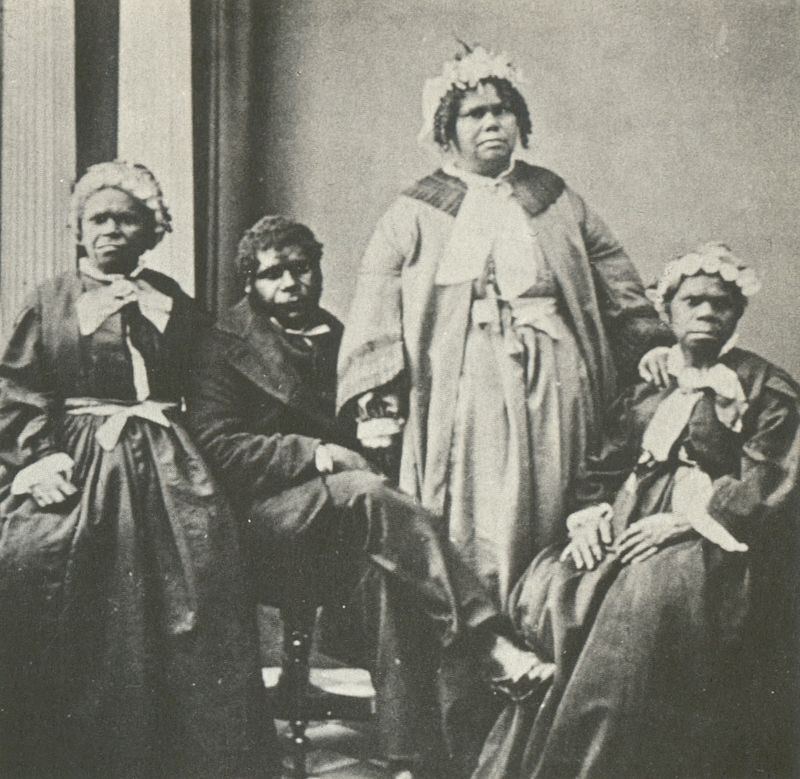Truganini was born in 1812 on Bruny Island – located south of the Tasmanian capital Hobart and separated from the Tasmanian mainland by the D’Entrecasteaux Channel. She was a daughter of Mangana, Chief of the Bruny Island people. Her name was the word her tribe used to describe the gray saltbush Atriplex cinerea.

In her youth, she took part in her people’s traditional culture, but Aboriginal life was disrupted by the European invasion. When Lieutenant-Governor George Arthur arrived in Van Diemen’s Land in 1824, he implemented two policies to deal with the growing conflict between settlers and the Aborigines. First, bounties were awarded for the capture of Aboriginal adults and children, and secondly, an effort was made to establish friendly relations with Aborigines in order to lure them into camps. The campaign began on Bruny Island where there had been fewer hostilities than in other parts of Tasmania.
When Truganini met George Augustus Robinson, the Protector of Aborigines, in 1829, her mother had been killed by sailors, her uncle shot by a soldier, her sister abducted by slavers, and her fiancé brutally murdered by timber-cutters, who then repeatedly sexually abused her. In 1830, Robinson moved Truganini and her husband, Woorrady, to Flinders Island with the last surviving Tasmanian Aborigines, numbering approximately 100. The stated aim of isolation was to save them, but many of the group died from influenza and other diseases. In 1838 Truganini also helped Robinson to establish a settlement for mainland Aborigines at Port Phillip.

Oral histories of Truganini report that after arriving in the new settlement of Melbourne and disengaging with Robinson, she had a child named Louisa Esmai with John Strugnell at Point Nepean in Victoria. Further, Truganini was from the bloodlines of Victoria’s Kulin Nation tribes. Indeed, they hid the child from authorities hunting Truganini. After Truganini was captured and exiled, her daughter Louisa was raised in the Kulin Nation. Louisa married John Briggs and supervised the orphanage at Coranderrk Aboriginal Reserve when it was managed by Wurundjeri leaders, including Simon Wonga and William Barak. According to a report in The Times, she later married a Tasmanian known as “King Billy” who died in March 1869. By 1873, Truganini was the sole survivor of the Oyster Cove group and was again moved to Hobart. She died three years later and was buried at the former Cascades Female Factory, a work camp for female convicts.
Prior to her death, Truganini had pleaded to colonial authorities for a respectful burial and requested that her ashes be scattered in the D’Entrecasteaux Channel. She feared that her body would be dissected and analyzed for scientific purposes as Aboriginal Tasmanian Wiliam Lenne’s body had been. Despite her wishes, within two years, her skeleton was exhumed by the Royal Society of Tasmania and later placed on display. Only in April 1976, approaching the centenary of her death, Truganini’s remains were finally cremated and scattered according to her wishes.

Truganini is often considered to be the last full-blood speaker of a Tasmanian language. However, The Companion to Tasmanian History details three full-blood Tasmanian Aboriginal women, Sal, Suke, and Betty, who lived on Kangaroo Island in South Australia in the late 1870s and “all three outlived Truganini.” There were also Tasmanian Aborigines living on Flinders and the Lady Barron Islands. Fanny Cochrane Smith (1834–1905) outlived Truganini by 30 years, and in 1889 was officially recognized as the last full-blood Tasmanian Aboriginal. Smith recorded songs in her native language, the only audio recordings that exist of an indigenous Tasmanian language.
In 1997 the Royal Albert Memorial Museum, Exeter, England, returned Truganini’s necklace and bracelet to Tasmania. In 2002, some of her hair and skin were found in the collection of the Royal College of Surgeons of England and returned to Tasmania for burial.
In 1835 and 1836, settler Benjamin Law created a pair of busts depicting Truganini and Woorrady in Hobart Town that has come under recent controversy. In 2009, members of the Tasmanian Aboriginal Centre protested an auction of these works by Sotheby’s in Melbourne, arguing that the sculptures were racist, perpetuated false myths of Aboriginal extinction, and erased the experiences of Tasmania’s remaining indigenous populations. Representatives called for the busts to be returned to the aboriginal community, and were ultimately successful in stopping the auction.
